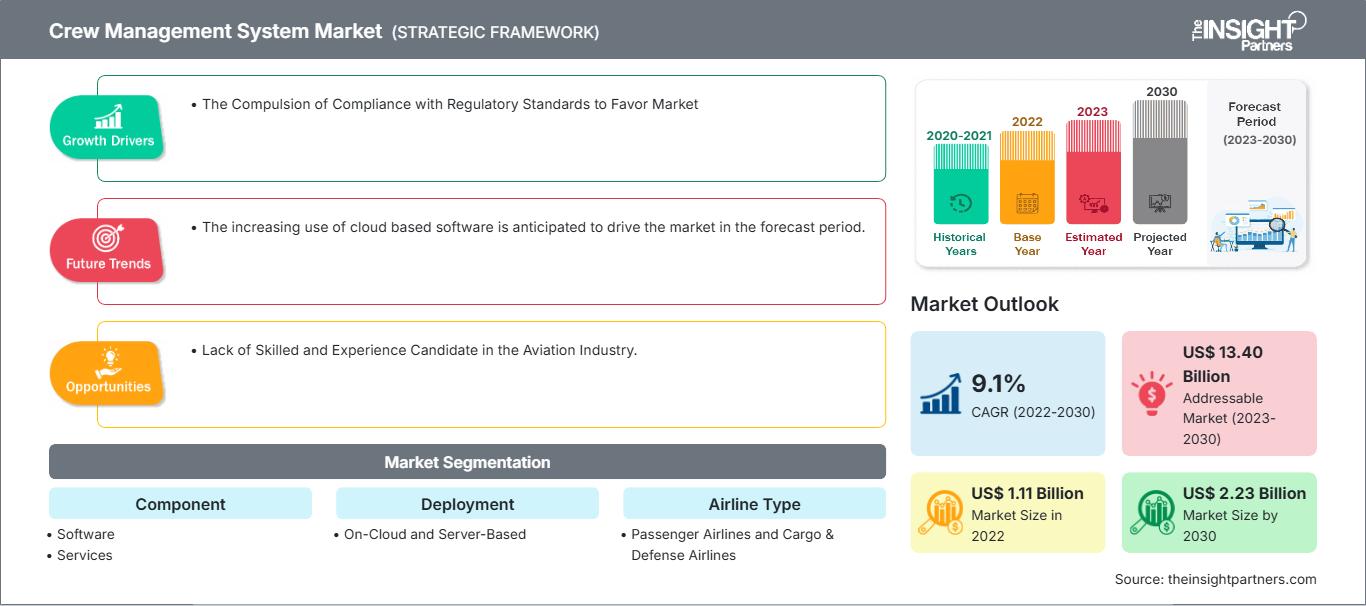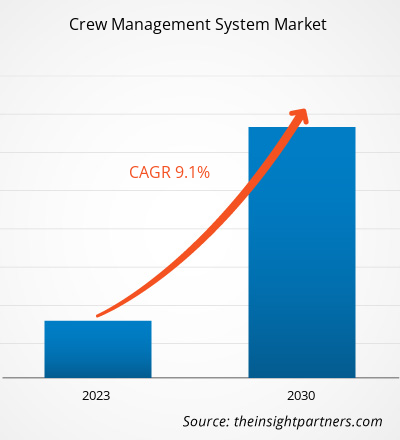机组管理系统市场规模预计将从 2022 年的 11.1 亿美元增至 2030 年的 22.3 亿美元。预计该市场在 2022 年至 2030 年期间的复合年增长率将达到 9.1%。航空业的快速发展和对高效机组管理解决方案日益增长的需求可能仍将是市场的主要趋势。
机组管理系统市场分析
随着监管标准合规要求的不断提高以及航空业的快速发展,机组管理系统市场的需求预计也将增长。此外,对高效机组管理解决方案日益增长的需求也推动了市场的增长。此外,低成本远程航班的扩张以及航空业技术熟练且经验丰富的人才的短缺,为市场带来了巨大的机遇。
机组管理系统市场概览
机组管理系统旨在随时提供有关机组人员的信息。它可帮助用户提供关于列车乘务员在本站或外站的在位情况,维护他们的状态记录,并分配列车乘务员。它还应维护关于定期休息和其他休息、道路学习、牵引知识、培训计划、PME、DAR 行动等信息。
自定义此报告以满足您的要求
您将免费获得任何报告的定制,包括本报告的部分内容,或国家级分析、Excel 数据包,以及为初创企业和大学提供超值优惠和折扣
船员管理系统市场: 战略洞察

-
获取本报告的主要市场趋势。这个免费样本将包括数据分析,从市场趋势到估计和预测。
机组管理系统市场驱动力与机遇
强制遵守监管标准以利于市场
航空公司和其他航空运输公司的首要任务是确保遵守其运营规定。由于管理机组人员飞行时间、休息限制和值班的规章制度十分复杂,机组排班是监管合规流程中的一个重要环节。机组排班系统在确认遵守这些法律方面发挥着至关重要的作用,它可以降低违规风险和相关处罚。此外,合规性也很重要,机组管理软件可以帮助确保遵守相关的国际海事法规,例如《国际培训、发证和值班标准公约》(STCW)和《海事劳工公约》(MLC)。因此,强制遵守监管标准推动了市场增长。
航空业缺乏技术熟练且经验丰富的候选人。
航空业缺乏技术熟练且经验丰富的候选人,这为机组管理系统市场带来了大量机遇。由于技术熟练的候选人较少,航空公司需要最大限度地提高现有员工的生产力和效率。机组管理系统可以帮助优化机组人员排班,确保有效利用现有人才,减少停机时间,并提高整体运营效率。它还有助于增强培训和发展工具,改进招聘流程,留住现有人才,以及合规和安全管理等。
机组管理系统市场报告细分分析
有助于得出机组管理系统市场分析的关键细分是组件、部署、航空公司类型和应用程序。
- 根据组件,机组管理系统市场分为软件和服务。预计软件部分将在预测期内占据相当大的份额。
- 根据部署情况,机组管理系统市场分为云端和基于服务器两种。预计云端部分将在预测期内占据相当大的份额。
- 根据航空公司类型,机组管理系统市场分为客运航空公司和货运及国防航空公司。预计客运航空公司部分将在预测期内占据相当大的份额。
- 根据应用,市场细分为机组运营和机组培训。预计机组运营部分将在预测期内占据相当大的份额。
按地区划分的机组管理系统市场份额分析
机组管理系统市场报告的地理范围主要分为五个区域:北美、亚太地区、欧洲、中东和非洲以及南美和中美洲。
北美在机组管理系统市场占据主导地位。增长归功于北美的技术进步。人工智能 (AI) 和机器学习 (ML) 等技术的融合正在提升机组管理系统的效率和功能。此外,对数字化和研发的关注也推动了北美市场的增长。此外,日益转向基于云的解决方案、法规合规性和运营效率、战略合作伙伴关系和投资,也推动着机组管理软件市场的发展。
机组管理系统市场
船员管理系统市场
The Insight Partners 的分析师已详尽阐述了预测期内影响机组管理系统市场的区域趋势和因素。本节还讨论了北美、欧洲、亚太地区、中东和非洲以及南美和中美洲的机组管理系统市场细分和地域分布。
船员管理系统市场报告范围
| 报告属性 | 细节 |
|---|---|
| 市场规模 2022 | US$ 1.11 Billion |
| 市场规模 2030 | US$ 2.23 Billion |
| 全球复合年增长率 (2022 - 2030) | 9.1% |
| 历史数据 | 2020-2021 |
| 预测期 | 2023-2030 |
| 涵盖的领域 |
By 组件
|
| 覆盖地区和国家 |
北美
|
| 市场领导者和主要公司简介 |
|
机组管理系统市场参与者密度:了解其对业务动态的影响
由于消费者偏好的不断变化、技术进步以及对产品优势的认知度不断提高等因素,最终用户需求不断增长,推动了机组管理系统市场快速增长。随着需求的增长,企业正在扩展其产品线,不断创新以满足消费者需求,并利用新兴趋势,从而进一步推动市场增长。

- 获取 船员管理系统市场 主要参与者概述
机组管理系统市场新闻及最新发展
机组管理系统市场评估通过收集一手和二手研究后的定性和定量数据进行,这些数据包括重要的公司出版物、协会数据和数据库。以下列出了机组管理系统市场的一些发展:
- 印度航空宣布即将推出一套新的机组管理系统,这将有助于加强排班规则,并加快航班中断后的恢复速度。
(来源:印度航空,公司网站,2024 年 4 月)
- OSM 和海洋技术集团 (Ocean Technologies Group) 建立了战略合作伙伴关系,为机队、机组人员和学习管理提供运营支持。为了进一步加强其长期数字战略,领先的船舶管理公司 OSM 与 Ocean Technologies Group (OTG) 建立了战略合作伙伴关系。
(来源:OSM,公司网站,2022 年 4 月)
船员管理系统市场报告范围和交付成果
“船员管理系统市场规模和预测(2020 年-2030 年)”报告提供了涵盖以下领域的市场详细分析:
- 机组管理系统市场规模以及涵盖范围内所有关键细分市场的全球、区域和国家/地区预测
- 机组管理系统市场趋势以及市场动态,例如驱动因素、限制因素和关键机遇
- 详细的 PEST/波特五力模型和 SWOT 分析
- 机组管理系统市场分析涵盖关键市场趋势、全球和区域框架、主要参与者、法规和最新市场发展
- 行业格局和竞争分析涵盖市场集中度、热图分析、知名参与者和机组管理系统市场的最新发展。
- 详细的公司简介
- 历史分析(2 年)、基准年、预测(7 年)及复合年增长率
- PEST和SWOT分析
- 市场规模、价值/数量 - 全球、区域、国家
- 行业和竞争格局
- Excel 数据集
近期报告
相关报告
客户评价
购买理由
- 明智的决策
- 了解市场动态
- 竞争分析
- 客户洞察
- 市场预测
- 风险规避
- 战略规划
- 投资论证
- 识别新兴市场
- 优化营销策略
- 提升运营效率
- 顺应监管趋势






















 获取免费样品 - 船员管理系统市场
获取免费样品 - 船员管理系统市场